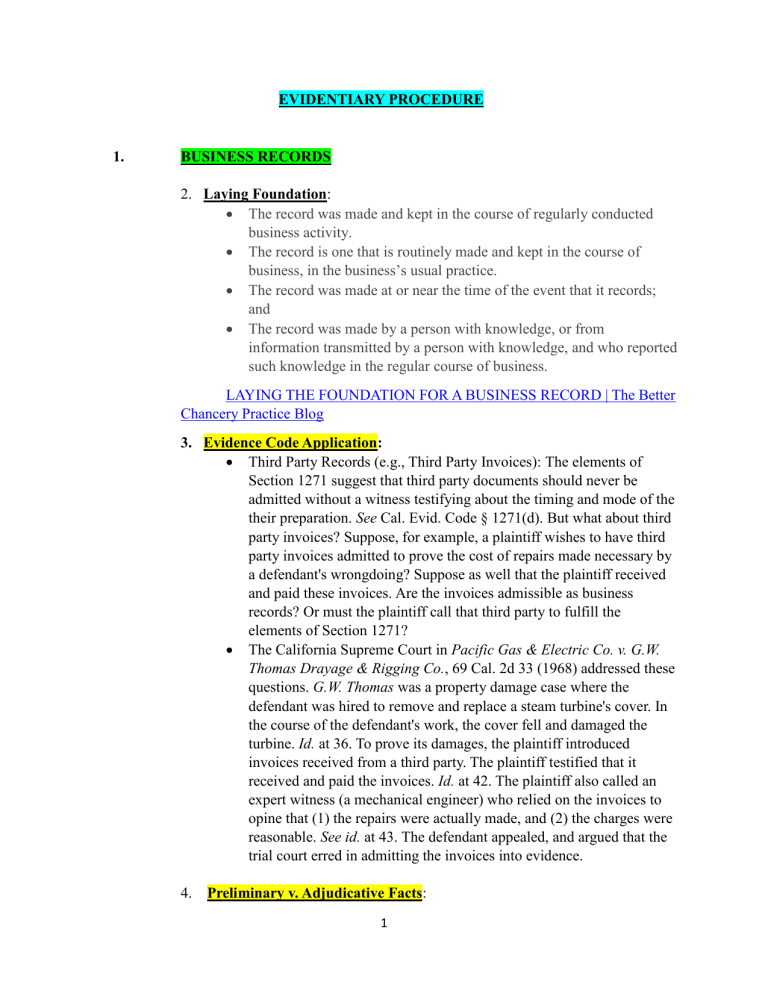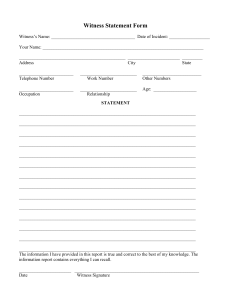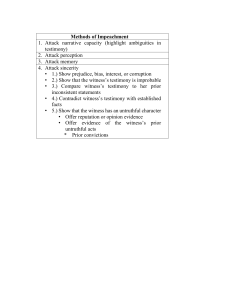
EVIDENTIARY PROCEDURE 1. BUSINESS RECORDS 2. Laying Foundation: The record was made and kept in the course of regularly conducted business activity. The record is one that is routinely made and kept in the course of business, in the business’s usual practice. The record was made at or near the time of the event that it records; and The record was made by a person with knowledge, or from information transmitted by a person with knowledge, and who reported such knowledge in the regular course of business. LAYING THE FOUNDATION FOR A BUSINESS RECORD | The Better Chancery Practice Blog 3. Evidence Code Application: Third Party Records (e.g., Third Party Invoices): The elements of Section 1271 suggest that third party documents should never be admitted without a witness testifying about the timing and mode of the their preparation. See Cal. Evid. Code § 1271(d). But what about third party invoices? Suppose, for example, a plaintiff wishes to have third party invoices admitted to prove the cost of repairs made necessary by a defendant's wrongdoing? Suppose as well that the plaintiff received and paid these invoices. Are the invoices admissible as business records? Or must the plaintiff call that third party to fulfill the elements of Section 1271? The California Supreme Court in Pacific Gas & Electric Co. v. G.W. Thomas Drayage & Rigging Co., 69 Cal. 2d 33 (1968) addressed these questions. G.W. Thomas was a property damage case where the defendant was hired to remove and replace a steam turbine's cover. In the course of the defendant's work, the cover fell and damaged the turbine. Id. at 36. To prove its damages, the plaintiff introduced invoices received from a third party. The plaintiff testified that it received and paid the invoices. Id. at 42. The plaintiff also called an expert witness (a mechanical engineer) who relied on the invoices to opine that (1) the repairs were actually made, and (2) the charges were reasonable. See id. at 43. The defendant appealed, and argued that the trial court erred in admitting the invoices into evidence. 4. Preliminary v. Adjudicative Facts: 1 An adjudicative fact is, like its name suggests, a fact to which the law is applied in the process of adjudication. “They are the facts that normally go to the jury in a jury case.” Fed. R. Evid. 201 Adv. Comm. Notes. A preliminary fact is “a fact upon the existence or nonexistence of which depends the admissibility or inadmissibility of evidence.” Cal. Evid. Code § 400. Examples of preliminary facts include the qualification of a witness, the existence of a privilege, and the admission of evidence. Id.; Fed. R. Evid. 104(a). For example, an adjudicative fact could be whether a defendant driver ran a red light when entering an intersection. The plaintiff wishes to call a witness who will testify that the light was indeed red. The preliminary fact is whether the witness is qualified to testify. In other words, did the witness personally see the light? See e.g., Cal. Evid. Code § 702 (“[T]he testimony of a witness concerning a particular matter is inadmissible unless he has personal knowledge of the matter….”). For the judge to allow the jury to hear the witness’ testimony to decide the adjudicative fact, the judge must first determine the preliminary fact question of whether the witness saw the light. 5. Relevance, Authentication and Foundation (of Evidence): Documentary evidence must be properly authenticated and a foundation laid before it can be admitted at trial. While there are classes of documents with special requirements, laying a foundation generally requires the following steps described in detail below: • identification and authentication, • relevance and no undue prejudice, • hearsay exception, and • the best evidence rule. It should be noted that, at trial, you should make every effort to confer with opposing counsel in advance to work out any foundation issues and agree whether copies may be used at trial. At the final pretrial conference, counsel customarily agree on whether exhibits can be marked as full exhibits or for identification only. The latter are then taken up via motions in limine before evidence begins or during trial. Microsoft Word - Chapter 09 Final.doc (shipmangoodwin.com) 6. Opinion Testimony Rules: If a witness is not testifying as an expert, testimony in the form of an opinion is limited to one that is: (a) rationally based on the witness’s perception; (b) helpful to clearly understanding the witness’s testimony or to determining a fact in issue; and 2 (c) not based on scientific, technical, or other specialized knowledge within the scope of Rule 702. Rule 701. Opinion Testimony by Lay Witnesses | Federal Rules of Evidence | US Law | LII / Legal Information Institute (cornell.edu) 7. Admissibility of Writings: Microsoft Word - ARTICLE_9__RULES.docx (nycourts.gov) 3


